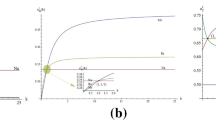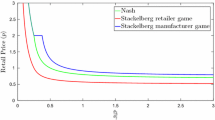Abstract
We consider a supply chain in which a manufacturer stimulates his retailers investing more local advertising expenditures through a cooperative advertising program (Co-op). Co-op advertising programs usually involve two important contractual terms, a participation rate and an accrual rate. While previous literatures have discussed the participation rate excessively, they seldom study the role of the accrual rate in cooperative advertising. To investigate the impact of the accrual rate on cooperative advertising decisions, we develop a dynamic cooperative advertising model for a single manufacturer–single retailer supply chain that incorporates the participation rate and the accrual rate simultaneously. We derive the equilibrium co-op decisions of two channel members, including the manufacturer’s national advertising efforts and his participation rate, as well as the retailer’s local advertising expenditure. Our analysis of the equilibrium solutions shows that an increase in participation rate will not always increase the retailer’s advertising efforts because of the accrual rate. Also, both the manufacturer and retailer can benefit from a high accrual rate.







Similar content being viewed by others
Notes
A 30 % participation rate means that the manufacturer will pay for 30 % of the retailer’s local advertising expenditures. A 4 % accrual rate means that the manufacturer will pay for local advertising expenses up to 4 % of the purchases made by the retailer.
References
Aust G, Buscher U (2012) Vertical cooperative advertising and pricing decisions in a manufacturer–retailer supply chain: a game-theoretic approach. Eur J Oper Res 223(2):473–482
Aust G, Buscher U (2014) Cooperative advertising models in supply chain management: a review. Eur J Oper Res 234(1):1–14
Bass FM, Krishnamoorthy A, Prasad A, Sethi SP (2005) Generic and brand advertising strategies in a dynamic duopoly. Market Sci 24(4):556–568
Berger PD (1973) Statistical decision analysis of co-op advertising ventures. J Oper Res Soc 24(2):207–216
Chintagunta PK, Jain D (1992) A dynamic model of channel member strategies for marketing expenditures. Market Sci 11(2):168–188
Crimmins EC (1980) Co-op advertising: a history of problems and promise. Advert Age, September 1, 1980, s1, s10, s11
Dant RP, Berger PD (1996) Modeling cooperative advertising decisions in franchising. J Oper Res Soc 47(9):1120–1136
Dutta S, Bergen M, John G, Rao A (1995) Variations in the contractual terms of cooperative advertising contracts: an empirical investigation. Market Lett 6(1):15–22
He X, Krishnamoorthy A, Prasad A, Sethi SP (2011) Retail competition and co-op advertising. Oper Res Lett 39(1):11–16
He X, Krishnamoorthy A, Prasad A, Sethi SP (2012) Co-op advertising in dynamic retail oligopolies. Decis Sci 43(1):73–106
He X, Prasad A, Sethi SP (2009) Co-op advertising and pricing in a stochastic supply chain: feedback Stackelberg strategies. Prod Oper Manag 18(1):78–94
Huang ZM, Li SX (2001) Co-op advertising models in manufacturer-retailer supply chains: a game theory approach. Eur J Oper Res 135(3):527–544
Hutchins MS (1953) Cooper Advert. Roland Press, New York
Jørgensen S, Sigué SP, Zaccour G (2000) Dynamic co-op advertising in a channel. J Retail 76(1):71–92
Jørgensen S, Taboubi S, Zaccour G (2001) Co-op advertising in a marketing channel. J Optim Theory Appl 110(1):145–158
Jørgensen S, Taboubi S, Zaccour G (2003) Retail promotions with negative brand image effects: Is cooperation possible? Eur J Oper Res 150(2):395–405
Jørgensen S, Zaccour G (2014) A survey of game-theoretic models of cooperative advertising. Eur J Oper Res 237(1):1–14
Karray S, Zaccour G (2005) A differential game of advertising for national brand and store brands. In: Haurie A, Zaccour G (eds) Dynamic games: theory and applications. Springer, Berlin, pp 213–229
Karray S, Zaccour G (2007) Effectiveness of coop advertising programs in competitive distribution channels. Int Game Theory Rev 9(2):151–167
Kotler P, Pfoertsch W (2010) Ingredient branding: making the invisible visible. Springer, New York
Li SX, Huang ZM, Zhu J, Chau PYK (2002) Co-op advertising, game theory and manufacturer–retailer supply chains. Omega 30(5):347–357
Moorthy KS (1988) Product and price competition in a duopoly. Market Sci 7(2):141–168
Nagler MG (2006) An exploratory analysis of the determinants of cooperative advertising participation rates. Market Lett 17(2):91–102
Nerlove M, Arrow KJ (1962) Optimal advertising policy under dynamic conditions. Economica 29(14):129–142
Prasad A, Sethi SP (2004) Competitive advertising under uncertainty: a stochastic differential game approach. J Optim Theory Appl 123(1):163–185
Sethi SP (1983) Deterministic and stochastic optimization of a dynamic advertising model. Optim Control Appl Methods 4(2):179–184
SeyedEsfahani MM, Biazaran M, Gharakhani M (2011) A game theoretic approach to coordinate pricing and vertical co-op advertising in manufacturer–retailer supply chains. Eur J Oper Res 211(2):263–273
Shugan SM (1985) Implicit understandings in channels of distribution. Manag Sci 31(4):435–460
Sigué SP, Chintagunta P (2009) Advertising strategies in a franchise system. Eur J Oper Res 198(2):655–665
Szmerekovsky JG, Zhang J (2009) Pricing and two-tier advertising with on manufacturer and on retailer. Eur J Oper Res 192(3):904–917
Weng ZK (1995) Channel coordination and quantity discounts. Manag Sci 41(9):1509–1522
Xie JX, Neyret A (2009) Co-op advertising and pricing models in manufacturer–retailer supply chains. Comput Ind Eng 56(4):1375–1385
Xie J, Wei JC (2009) Coordinating advertising and pricing in a manufacturer–retailer channel. Eur J Oper Res 197(2):785–791
Yue J, Austin J, Wang M, Huang ZM (2006) Coordination of co-op advertising in a two-level supply chain when OEM offers discount. Eur J Oper Res 168(1):65–86
Zhang J, Gou Q, Liang L, Huang Z (2013a) Supply chain coordination through cooperative advertising with reference price effect. Omega Int J Manag Sci 41(2):345–353
Zhang J, Gou Q, Liang L, He X (2013b) Ingredient branding strategies in a dynamic supply chain: models and analysis. Int J Prod Res 51(23–24):6923–6949
Acknowledgments
This work was supported by the National Natural Science Foundation of China (Grant Nos. 70901068, 71271198), the Funds for International Cooperation and Exchange of the National Natural Science Foundation of China (Grant No.71110107024), Chinese Universities Scientific Fund and Fundamental Research Funds for the Central Universities (2014B14814). Qinglong Gou would also like to acknowledge the Science Fund for Creative Research Groups of the National Natural Science Foundation of China (Grant No. 71121061) for support of his research.
Author information
Authors and Affiliations
Corresponding author
Appendix
Appendix
1.1 Proof of Proposition 1
With the determined cooperative advertising program of the manufacturer, the optimization problem of the retailer can be specified as
s.t.
where
The Hamilton–Jacobi–Bellman (HJB) equation is given by
The first-order condition for the maximization in (22) leads to
Recall the retailer’s profit function at time t in Eq. (4)
where \(\pi _r (t)\) is continuous when \(a = \left( {{\rho _{m}}yM^\eta /x} \right) ^{\frac{1}{{1 - \gamma }}}\).
We solve the first derivative of \(\pi _r\) with respect to a as
To solve the best response in local advertising investment for the retailer, we seek for the left derivative of \(\pi _r(t)\) when \(a = \left( {{\rho _{m}}yM^\eta /x} \right) ^{\frac{1}{{1 - \gamma }}}\) is
and the right derivative is
According to \(0 < \gamma < 1\), we get
which leads to the following three possible cases as well as the corresponding best response in advertising investment.
(i) If \({\rho _{r}} < {\rho _{m}}y\left( {1 - x} \right) /(\gamma x)\), i.e.,
the retailer will get his best response in local advertising investment when \(a < \left( {{\rho _{m}}yM^\eta /x} \right) ^{\frac{1}{{1 - \gamma }}}\). Utilizing (21), we can obtain the retailer’s best response in local advertising investment is \(a\left( M \right) \mathrm{{ = }}\left[ {\gamma {\rho _{r}}M^\eta /(1 - x)} \right] ^{\frac{1}{{^{1 - \gamma } }}}\).
(ii) If \({\rho _{m}}y\left( {1 - x} \right) /(\gamma x) \le {\rho _{r}} \le {\rho _{m}}y\left( {1 - \gamma x} \right) /(\gamma x)\), i.e.,
the retailer’s best response in advertising investment is achieved when \(a\left( M \right) = \left( {{\rho _{m}}yM^\eta /x} \right) ^{\frac{1}{{1 - \gamma }}}\).
(iii) If \({\rho _{r}} > {\rho _{m}}y\left( {1 - \gamma x} \right) /(\gamma x)\), i.e.,
the retailer gets his optimal local advertising investment when \(a > ( \frac{{\rho _{m}}yM^\eta }{x})^{\frac{1}{{1 - \gamma }}}\) and we obtain that the retailer’s best response in local advertising investment is \(a = \left( {\gamma ({\rho _{r}} + {\rho _{m}}y)M^\eta } \right) ^{\frac{1}{{1 - \gamma }}}\) by utilizing (26).
1.2 Proof of Proposition 2
Under the assumption that \(\gamma + \eta /2\mathrm{{ = }}1\), the optimization problem of the manufacturer can be specified as
s.t.
The Hamilton–Jacobi–Bellman (HJB) equation is given by
where \(\varDelta (x)\) is given by Eq. (9).
The first-order condition for the maximization in (28) leads to
Substituting (29) into (28), one has
Conjecture the following form of the value function
where the coefficients \(a_i(i=0,1,2)\) are to be determined.
Substituting (31) into (30) renders
Solving Eqs. (32)–(34) and for the sake of stability, we have
Then we get the feedback strategy of the manufacturer’s national advertising
1.3 Proof of Proposition 3
Substituting the feedback national advertising of the manufacturer in Proposition 2 into the goodwill dynamic equation, we have
Solving Eq. (36), we get the trajectory of the goodwill level is
Substituting (37) into a(M) and u(M) in Propositions 1 and 2, respectively, we get the best response in local advertising expenditure is
and the best response in national advertising effort is
1.4 Proof of Proposition 4
The manufacturer makes decisions on participation rate by solving his maximization problem given by Eq. (8). The HJB equation is given by
where
and \(A = {\rho _{m}}y/(\gamma {\rho _{r}} + {\rho _{m}}y)\), \(B = {\rho _{m}}y/\left( {\gamma \left( {{\rho _{r}} + {\rho _{m}}y} \right) } \right) \).
To get the optimal participation rate, we first examine the first-order condition for the maximization of \(V_m\) which leads to
and discuss the optimal participation rate under three conditions sequentially:
-
(i)
When \(x<A\), letting \(\partial V_m (M)/\partial x = 0\), we get the solution \(x^*\) denoted by
$$\begin{aligned} x^\mathrm{{*}} = \frac{{\partial \varDelta (x)}}{{\partial x}}\mathrm{{ = }}\frac{{\gamma {\rho _{r}} + {\rho _{m}} - {\rho _{r}}}}{{\gamma {\rho _{r}} + {\rho _{m}}}}. \end{aligned}$$Furthermore, because
$$\begin{aligned} \left. {\frac{{\partial ^2 V_m (M)}}{{\partial x^2 }}} \right| _{x = \frac{{\gamma {\rho _{r}} + {\rho _{m}} - {\rho _{r}}}}{{\gamma {\rho _{r}} + {\rho _{m}}}}} = - \frac{1}{{(1 - \gamma ){\rho _{r}}^2 }}(\gamma {\rho _{r}} + {\rho _{m}})^2 (\gamma ^2 {\rho _{r}} + \gamma {\rho _{m}})^{\frac{1}{{1 - \gamma }}} < 0, \end{aligned}$$we can conclude that the manufacturer gets his optimal participation rate at \(x\mathrm{{ = }}(\gamma {\rho _{r}} + {\rho _{m}} - {\rho _{r}})/(\gamma {\rho _{r}}+ {\rho _{m}})\) when \(x<A\).
-
(ii)
When \(A \le x \le B\), we get the first derivative of \(V_m(M)\) with respect to x as
$$\begin{aligned} \frac{{\partial V_m (M)}}{{\partial x}} = - \frac{{(1 - y)\gamma }}{{y(1 - \gamma )}}(\frac{{{\rho _{m}}y}}{x})^{\frac{1}{{1 - \gamma }}}. \end{aligned}$$(42)From Eq. (38), we get \(\partial V_m (M)/\partial x < 0\), which indicates the manufacturer’s value function is a monotone decreasing function of x. Thus the manufacturer gets the maximum of the present value of the profit at \(x=A\) when \(A \le x \le B\).
-
(iii)
We can eliminate the condition \(x>B\) from consideration for obtaining the manufacturer’s optimal participation rate because we can prove that the manufacturer’s profit under this condition is always smaller than that under the second condition.
In summary, owing to \(V_m\) is a continuous function, the optimal participation rate of the manufacturer is
where \({\hat{y}} = \gamma \left( {{\rho _{m}} - \left( {1 - \gamma } \right) {\rho _{r}}} \right) /{\rho _{m}}\).
Substituting the optimal participation rate into Eqs. (12)–(14), we can get the manufacturer’s equilibrium advertising efforts is
the manufacturer’s goodwill stock along with time t is
and the retailer’s equilibrium local advertising expenditure is
where
and \({\hat{y}} = \gamma \left( {\rho _{m} - \left( {1 - \gamma } \right) {\rho _{r}} } \right) /{\rho _{m}}\).
Rights and permissions
About this article
Cite this article
Zhang, J., Gou, Q., Li, S. et al. Cooperative Advertising with Accrual Rate in a Dynamic Supply Chain. Dyn Games Appl 7, 112–130 (2017). https://doi.org/10.1007/s13235-015-0165-z
Published:
Issue Date:
DOI: https://doi.org/10.1007/s13235-015-0165-z




